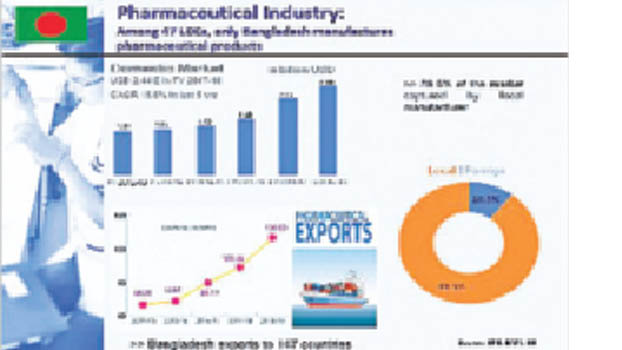Global Pharmaceuticals and Bangladesh

KSM Mostafizur Rahman
KSM Mostafizur Rahman The number of global citizens has been increasing with the pace of time. Besides, the biodiversity of the earth is experiencing rapid changes in environment and ecological balance. The food habit and lifestyle are going through changes having impact on human body. These factors are contributing to new types of diseases and viruses gradually. To fight the diseases, the scientists conduct regular research and the pharmaceutical entrepreneurs add new elements to medicines. And the global market of pharmaceutical products is expanding as time passes; it is widely considered that the longevity of human lifespan will increase with the development of medical science in the future. To lead a long life, aged people will have to be more dependent on medicines. We can predict a revolution of medicine and biotechnology in the near future alongside technology-driven fourth industrial revolution. As a result, the global market of pharmaceutical products will get ultimate expansion. The pharmaceutical sector maintained a global market size of 1.2 trillion dollar in 2018, according to World Health Organization and Harvard Business Review. The market grew by around 5.8 per cent than in the previous year The pharmaceutical industry's global market valuation was 390 billion dollar in 2001 and the sector experienced rapid growth in the last 19 years. Except the information technology sector, pharmaceuticals had maintained maximum growth than other sectors in the last two decades. The industry has to maintain standard including - modern technology adaptation, increasing research allocation, infrastructure development cost and strong competition. Thus the entrepreneurs must have regulatory support from the government to face new challenges to keep standard in the medicine market. Mckinsy and Company suggested that the North America and Western Europe territories consume half of total production volume in global pharmaceuticals sector. Around 1 billion people in the territories consumed 56 per cent of global medicine while 44 per cent products was consumed by the remaining 650 crore people living in others parts of the world. The third growing market is the Asia Pacific regions where buying capacity of people in line with emerging economic development will increase. Market analysts predict a 8.4 per cent growth in upcoming fiscal of 2020-21 in Asia Pacific region with increasing trends in gross domestic product (GDP) growth, government allocation and knowledge management. The medicines which have recently completed patent rights period, rapid growing drugs become upgraded to generic grade in the widely expanded markets. India and China have exploited the opportunities to market the expired patent products as generic drugs to the global markets. The size of global generic market was 340 billion dollars which will reach 475 billion dollar by 2024 according to the market insiders. As neighbours to India and China, Bangladesh has the opportunity to enter in the 475 billion dollar market of generic drug. To realise the opportunity, Bangladesh has to formulate special policy for medicine sector along side of taking several joint initiatives in public private sector. As the regulatory compliance in different here, the government has to formulate long-term strategy in participation of industry people, academics and researchers to grab the future opportunities. Bangladesh has low cost workforces and LDC country access. However, the country is lagging behind in other factors in global market. Bangladesh will loss the waivers under Intellectual Property Rights in 2024 when the country marches towards a developing one. The government has to take strategy within this time to face the next challenges. The generic bio-logic or bio-miler drugs will become popular in future. Experts prescribe bio-logic drugs in case of some chronic diseases. The global market of bio-logic drugs has been increasing as the market size was 4.49 billion dollar in 2017. The market will reach 24 billion dollar by next five years. In a recent interview with the BBC, Global pharma expert Prof Kees de Joncheere mentioned that the pharmaceuticals industry has served as well in term of developing good news medicine, but in the past 10-20 years there has been very little breakthrough in innovation. So, scientists have predicted that the bio-technology will contribute to the development of future of medical science. The developed countries have already begun large scale investment in research and development in the sector to catch the future businesses. Many old medicines will be replaced by new ones which would give better results. According to a recent article in Science Daily “Sequencing of human genome and the development of powerful and affordable DNA sequencing technologies has ushered in a new era of precision oncology, in which patients are treated with customized therapies designed to target the specific mutations with their tumour”. Companies that can design drugs that target disease at the molecular level while minimizing off target side effects and consider structural pharma cogenosmics could transform the structure of the pharmaceutical industry on cure disease with a significant level of precision. Bangladesh has been exporting medicine to developed countries keeping global compliance. We have provided the 98 percent medicine of local demand. The Bangladesh local medicine market is now worth of Tk 22,000 crore which will be doubled by 2024. Bangladesh exports drugs to 150 countries after fulfilling local demand. Local business-friendly policy, public-private cooperation, skilled workforce, patent rights waiver contributed to the growth. Our raw material and machineries are fully depended on imports, which is a big challenge for us in the global market. Now, we should focus on local raw material and machineries manufacturing for medicine sector to emerge a new tiger in global pharmaceuticals sector. The writer is the Managing Director, One Pharma & Investment analyst



